A Trip to Adobe Seattle, Where InDesign Is Made (Part 2)
Okay, everyone feeling refreshed from our initial exploration of the Adobe offices in Seattle? (If you haven’t seen the first half of the tour, read this first.) Let’s take a left here, then a right, good… okay, here we can see the Wall o’ InDesign Docs! This is but a very small sampling of documents created with InDesign, posted for inspiration, reflection, and enjoyment. The Wall includes pages from magazines, catalogs, technical documents, posters, books, and more. It’s pretty cool:
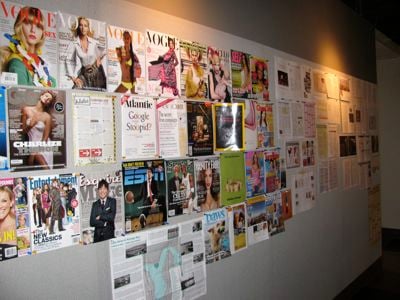
Okay, now down this hallway we find a different kind of wall display: The current state of bugs in the product. I don’t think it’s any secret that Adobe is forever tracking bug reports and trying to fix them. They make sure everyone on the team is aware of what kinds of bugs are still outstanding and their severity:

So what happens if someone on the QA testing team needs to check out a bug? Well, it’s off to the testing room, chock full o’ computers of all shapes and sizes, and a dizzying array of printers on racks, tables, and shelves in what is likely one of the largest single rooms at Adobe Seattle. Here’s a few Macs:
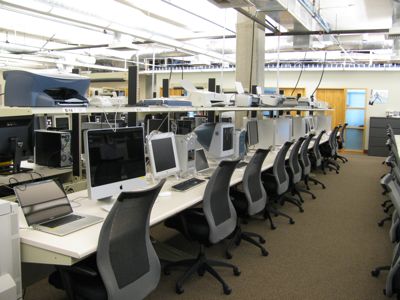
Don’t worry, PC users, Adobe has your back, too:

Hey, here comes John Cornicello! John runs Adobe’s forums. I’ve known John since he was a sysop in the old Compuserve days. He’s also a very good photographer in his own right (unlike me). And what’s that poster he’s holding?!

Now it’s time to head upstairs to see the code mines, where Adobe software engineers dig deep into the bowels of the earth with their bare hands and extract bits of code that they painstakingly piece together to form InDesign as we know it. They are brave souls, toiling endlessly (with frequent breaks to get more candy and Dr. Pepper) to serve us, the InDesign users. Here is Eric Menninga’s office (you may remember us talking about Eric, who wrote many of the typography features in InDesign):

Goodness, here’s some more folks sitting about, trying to get some work done. If you’ve ever read the little Splash screen that appears when you launch InDesign, you’ve seen these names: Paul Sorrick and Bob Freeman:
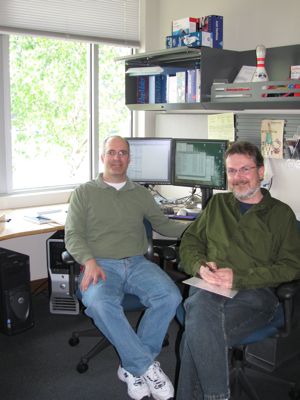
And here’s Olav Martin Kvern (a.k.a. Ole), Chuck Weger, and Jim Birkenseer! Ole actually works for Adobe (and also happens to be my exceptionally patient co-author on Real World InDesign). The other two are just brilliant groupies, scriptmasters and developers in their own right. (Actually, this was taken at the recent Developers conference at Adobe.)
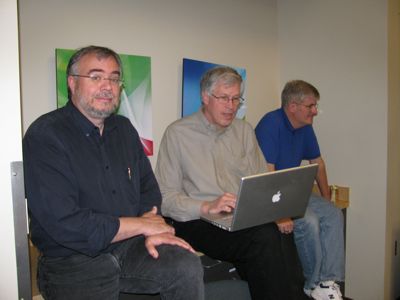
Now here’s Ole’s office, first from the outside and then through his window:
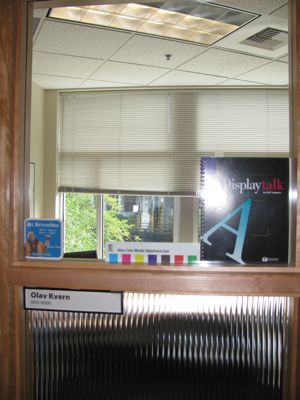
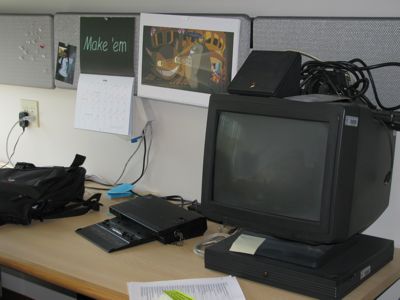
Okay, admittedly, that’s not the most exciting set of pictures you’ve ever seen of an office. But we’re limited in the amount of Top Secret information we’re allowed to see on this tour. And besides, that’s an original NeXT workstation from the dawn of time sitting there (unplugged) next to the Totoro calendar. That’s pretty awesome.
I’m getting hungry, so I’m going to head up to the cafeteria. But first, check this out: on the way to the elevator, the hallway opens up and we find the World Infamous Adobe Punching Bag:

We hear conflicting reports on how much this is used these days. Some say it’s just for decoration, even though there is a pair of real boxing gloves propped up on the window next to it (not in view here) and when tensions run high before shipping a new version, grunts and groans can distinctly be heard from this floor. That said, to me, the heavy chainmail curtain is even cooler than the bag.
Okay, let’s head upstairs (it’s only one more flight up to the top, so let’s take the stairwell) to the cafeteria. As we turn the bend, here, we see a framed set of historically interesting photos and objects. Many of these had been stored inside a time capsule by employees of Aldus Corporation during the 20th century and only recently re-opened:
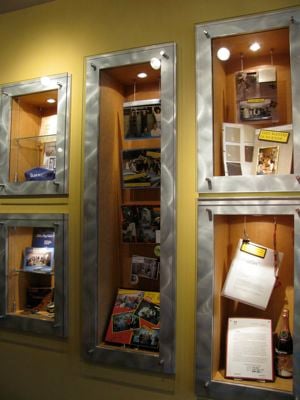
The most interesting item by far to me is an ImageWriter-printed document dated August 1984, with the original functional specs for a program called PageSet — which later was renamed PageMaker. Oh, it’s tempting to break that glass and read it!

All right, we now turn right and enter the place-du-eating, a state-of-the-art emporium of inexpensive-but-delicious-and-nutritious food:

The food here is secondary to only one thing: The view outside the large windows — especially on a gorgeous day like today! Here, let’s walk through this door to the outside deck. On the West side, we see the back courtyard and the Fremont bridge, which opens whenever tall-masted sailboats need to pass:

Turning to the East, we see the majestic Aurora bridge, many of Seattle’s famous houseboats, and, in the distance (actually beyond the trees on the right) downtown Seattle.

Well, that’s it for our tour today. I hope you’ve enjoyed yourself as much as I have. InDesign is an amazing program built by some amazing folks in a pretty amazing place. Okay, everyone downstairs again… but first, how about a few rounds on that punching bag… and some candy!




The PageSet paper just blow me away. Breathtaking, awesome, curious.
Thanx a lot, David from a spanish mac guy that knows you, since you wrote that book with Eric Taub ¿Remenber?
In Spain was published by Pagina Uno.
What about the publication of a book From Quark to InDesign (or a approximation) in spanish?
Thank you very much again
Ha! Fun times … great pictures! I’ve seen only about half of those places on the Adobe campus.
What is worrisome to me is the lack of *people* sitting at the bug-fixing computers though.
;-)
Thanks so much for sharing!
@krollian: Ah yes, I remember Pagina Uno and the Q-Tips book well. I would love there to be a Spanish version of my books, but it depends on the Spanish publishers, not me. Yo olvidé mi español del escuela venti-cinco años pasado. (Does that even mean anything?) ;)
@Anne-Marie: Fortunately, those machines aren’t the main workstations for fixing bugs. In fact, I should have been more clear: the testing lab is largely automated. Adobe runs thousands of different tests on different machines completely via automated programs. It’s only when something goes wrong that someone actually need to sit and use the UI. And those QA folks have their own offices/cubicles elsewhere.
The “Bug Stats” board is pretty sparse looking?
Cool sets of photos.
Thanks for sharing.
I had a chance to tour Adobe’s Seattle offices a couple times, so your post brings back great memories.
Thanks for sharing!
Yes, David.
I know this situation. Is a real, real pity that your books can not be seen in the spanish bookstores.
I think that there is a real market for your books in spanish.
An important base of users still work with the 3 magnificients:
FreeHand, Photoshop and XPress.
And we all know that ASAP all we shall move to Adobe products. Even some people will follow with XPress because of its wide and uncountable user base…
Keep on with your great blog. If I had more time to visit it…
You know, eMail, Youtube, Facebook and those things called work, sleep, family an so on…
See ya, David!